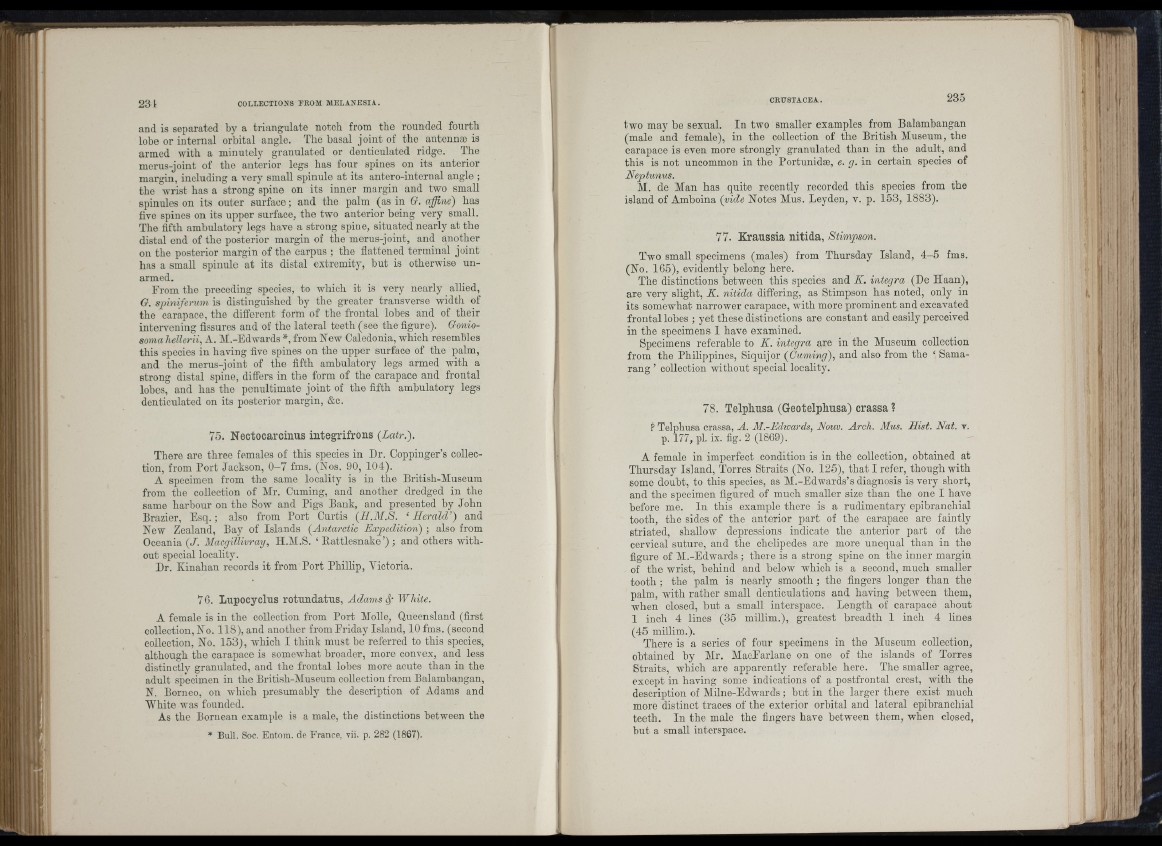
i i
3
M___l 1!
ill
I K
and is separated by a triangulate notch from the rounded fourth
lobe or internal orbital angle. The basal joint of the antennae is
armed with a minutely granulated or denticulated ridge. The
merus-joint of the anterior legs has four spines on its anterior
margin, including a very small spinule at its antero-internal angle ;
the wrist has a strong spine on its inner margin and two small
spinules on its outer surface; and the palm (as in G. affine) has
five spines on its upper surface, the two anterior being very small.
The fifth ambulatory legs have a strong spine, situated nearly at the
distal end of the posterior margin of the merus-joint, and another
on the posterior margin of the carpus ; the fiattened terminal joint
has a small spinule at its distal extremity, but is otherwise unarmed.
From the preceding species, to which it is very nearly allied,
G. spiniferum is distinguished by the greater transverse width of
the carapace, the different form of the frontal lobes and of their
intervening fissures and of the lateral teeth (see the figure). Goniosoma
heUerii, A. Al.-Edwards *, from New Caledonia, which resembles
this species iu having live spines on the upper surface of the palm,
and the merus-joint of the fifth ambulatory legs armed with a
strong distal spine, differs in tho form of the carapace and frontal
lobes, and has the penultimate joint of the fifth ambulatory legs
denticulated on its posterior margin, &c.
75. Nectocarcinus integrifrons (Latr.).
There are three females of this species in Dr. Coppinger’s collection,
from Port Jackson, 0 -7 fms. (Nos. 90, 104).
A specimen from the same locality is in the British-Aluseum
from the collection of Air. Cuming, and another dredged in the
same harbour on the Sow and Pigs Bank, and presented by John
Brazier, E s q .; also from Port Curtis (H.Al.S. ‘ Herald’) and
New Zealand, Bay of Islands (Antarctic Expedition) ; also from
Oceania (J. Alacgillivratj, H.Al.S. ‘ Battlesnake’) ; and others without
special locality.
Dr. Kinahan records it from Port Phillip, A^ictoria.
76. Lupocyclus rotundatus, Adams 4~ White.
A female is in the collection from Port Alolle, Q,neensland (first
collection, No. 118), and another from Eriday Island, 10 fms. (second
collection. No. 153), which I think must he referred to this species,
although the carapace is somewhat broader, more convex, and less
distinctly granulated, and the frontal lobes more acute than in the
adult specimen in the British-Aluseum collection from Balambangan,
N. Borneo, on which presumably the description of Adams and
AVhite was founded.
As the Bornean example is a male, the distinctions between the
235
two may be sexual. In two smaller examples from Balambangan
(male and female), in the collection of the British Aluseum, the
carapace is even more strongly granulated than in the adult, and
this is not uncommon in the Portunidse, e. g. in certain species of
Neptunus.
AI. de Alan has quite recently recorded this species from the
island of Amboina (vide Notes AIus. Leyden, v. p. 153, 1883).
77. Kraussia nitida, Stimpson.
Two small specimens (males) from Thursday Island, 4 -5 fms.
(No. 165), evidently belong here.
The distinctions between this species and K. integra (De Haan),
are very slight, K. nitida differing, as Stimpson has noted, only in
its somewhat narrower carapace, with more prominent and excavated
frontal lobes ; yet these distinctions are constant and easily perceived
in the specimens 1 have examined.
Specimens referable to K. integra are in the Aluseum collection
from the Philippines, Siquijor (Cuming), and also from the ‘ Samarang
’ collection without special locality.
78. Telphusa (Geotelphusa) crassa ?
P Telphusa crassa, A. M.-Echvards, Nouv. Arch. AIus. Hist. Nat. v.
p. 177, pi. ix. fig. 2 (1869). —
A female in imperfect condition is in the collection, obtained at
Thursday Island, Torres Straits (No. 125), th at I refer, though with
some doubt, to this species, as AI.-Edwards’s diagnosis is very short,
and the specimen figured of much smaller size than the one I have
before me. In this example there is a rudimentary epibranchial
tooth, the sides of the anterior p art of the carapace are faintly
striated, shallow depressions indicate the anterior part of the
cervical suture, and the chelipedes are more unequal than in the
figure of Al.-Edwards; there is a strong spine on the inner margin
of the wrist, behind and below which is a second, much smaller
to o th ; the palm is nearly smooth ; the fingers longer than the
palm, with rather small dentieulations and having between them,
when closed, but a small interspace. Length of carapace about
1 inch 4 lines (35 millim.), greatest breadth I inch 4 lines
(45 millim.).
There is a series of four specimens in the Alusenm collection,
ohtained by Air. AlacEarlane on one of the islands of Torres
Straits, which are apparently referable here. The smaller agree,
except in having some indications of a postfrontal crest, with the
description of Alilne-Edwards ; hnt in the larger there exist much
more distinct traces of the exterior orbital and lateral epibranchial
teeth. In the male the fingers have between them, when closed,
hnt a small interspace.
■t T. I ' I
■* -1 ' •
: ii
'! 9i
U '
if: ;
H i
1
' i h